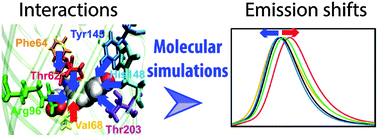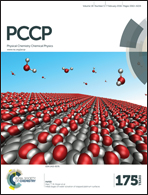Emission shaping in fluorescent proteins: role of electrostatics and π-stacking†
Abstract
For many decades, simulating the excited state properties of complex systems has been an intriguing but daunting task due to its high computational cost. Here, we apply molecular dynamics based techniques with interpolated potential energy surfaces toward calculating fluorescence spectra of the green fluorescent protein (GFP) and its variants in a statistically meaningful manner. With the GFP, we show that the diverse electrostatic tuning can shape the emission features in many different ways. By computationally modulating the electrostatic interactions between the chromophore phenoxy oxygen and its nearby residues, we demonstrate that we indeed can shift the emission to the blue or to the red side in a predictable manner. We rationalize the shifting effects of individual residues in the GFP based on the responses of both the adiabatic and the diabatic electronic states of the chromophore. We next exhibit that the yellow emitting variant, the Thr203Tyr mutant, generates changes in the electrostatic interactions and an additional π-stacking interaction. These combined effects indeed induce a red shift to emit the fluorescence into the yellow region. With the series of demonstrations, we suggest that our approach can provide sound rationales and useful insights in understanding different responses of various fluorescent complexes, which may be helpful in designing new light emitting proteins and other related systems in future studies.


 Please wait while we load your content...
Please wait while we load your content...